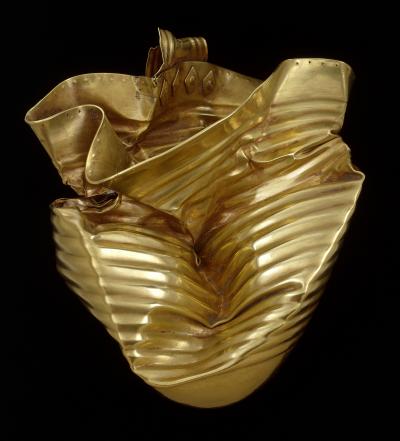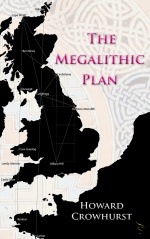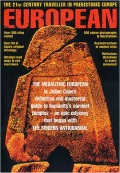<< News >> 4000 year old gold cup found buried in Kent field
Submitted by Andy B on Friday, 03 May 2002 Page Views: 13102
Digs
A Bronze Age corrugated golden cup, only the second of its kind ever found in Britain, has been unearthed from a prehistoric barrow mound in a field at Woodnesborough, near Sandwich, in Kent. An English Heritage funded excavation has now unearthed a burial site in the barrow after a local man discovered the exquisitely embossed four and a half-inch high cup nearby with a metal detector. Update: Pictures in our eGallery!
The cup, dating from 1700-1500 BC, is made from some of the oldest gold ever found in Britain, and is likely to be a ceremonial vessel perhaps made as an offering to a powerful local leader. Only someone of the highest status could have owned the cup, beaten with great skill from a solid lump of gold. Roughly contemporary with the stone circle at Stonehenge, it is one of the earliest treasures found in England, predating the Sutton Hoo burial by more than 2,500 years.
Archaeologists have found a grave pit containing fragmentary bones, possibly human. Though no whole skeleton has yet come to light this may be because the bones have been dispersed by animals or eroded by acidic soil. Excavation of the barrow has also produced Mesolithic and late Neolithic flint tools and pottery, showing that people have been living near the field at Ringlemere Farm, now a wind-swept expanse of winter wheat, since at least 5,000 BC.
David Miles, Chief Archaeologist of English Heritage said: "Thanks to the team of amateurs and professionals which brought to light this outstanding and internationally important find, we have been able to undertake the vital work of excavating the barrow and placing the magnificent cup in its context."
The cup bears a striking resemblance to the famous Rillaton gold cup, of a similar date, which was found buried with a human skeleton in Cornwall in 1837 and is now in the British museum. One side of the Kent cup, which is slightly larger than the Rillaton, has been crushed, probably by agricultural machinery which dragged it from its original resting place, but otherwise it is intact. Both have broad handles attached by rivets with lozenge shaped washers. Unlike the Rillaton cup, however, the Kent cup has a curved base. It is thought that the Rillaton cup, which now has a flat base and was for many years used by King George V to hold his collar studs, could originally have been similar.
Amateur archaeologist Cliff Bradshaw, who found the cup with a metal detector in a search fully sanctioned by the farm owners, said: "I'm thrilled that I spotted the barrow and found the cup about 18 inches below the surface, at the limit of my detector's range. I realised when I took the cup home and looked in a book that I'd discovered something similar to the Rillaton cup. I immediately rang Keith Parfitt of the Canterbury Archaeological Trust but he didn't believe me at first. He had a shock the next morning when he opened his post and saw the photos I sent him."
Cliff has been helping the archaeologists from Canterbury Archaeological Trust, who have been excavating under the supervision of English Heritage and Kent County Council, after a geophysical survey by English Heritage pinpointed the barrow. Volunteers from Dover Archaeological Group have also assisted the excavation.
Kent County Council Cabinet Member for Strategic Planning, Sarah Hohler said: "From the moment this remarkable find was reported we brought together local archaeologists, the Portable Antiquities Scheme, English Heritage, the British Museum and Dover Museum to learn as much as possible about this latest in a series of wonderful finds, such as the Dover Boat, which are firmly putting East Kent on the map of Bronze Age Britain. We are extremely grateful to the Smith family, the landowners, who have shown a great interest in the project and allowed us on to their land to carry out the work despite the presence of crops."
The cup was reported as an item of potential Treasure through Michael Lewis, who is the member of KCC's archaeological section and the local Finds Liaison Officer for the Portable Antiquities Scheme. Michael said: "The Portable Antiquities Scheme, through which members of the public can record chance archaeological discoveries, has helped many finders report items of archaeological interest. Kent has greatly benefited from the scheme."
It is not known where the gold cup was made but it shows that Kent was part of an early Bronze Age culture with richly furnished graves that had its main focus in Wessex and links with other parts of Britain and Europe. A very few cups in amber and shale of a similar date have been found with burials in southern Britain but these are mostly in fragments, have no proper contexts or have even been lost. A handful of cups in precious metal have also come to light on the continent. An emerging trade network was evidently carrying goods and ideas over long distances to be absorbed by different communities.
The cup is being held in the British Museum pending the outcome of a Coroner's Inquest to decide whether it constitutes Treasure under the Treasure Act 1996. If the Coroner decides that it does the British Museum will be given the chance to purchase it.
Stuart Needham, curator in charge of European Bronze Age Antiquities at the British Museum, said: "These exotic cups of the final Early Bronze Age are not only rare, but tell us about some key interactions between Britain and Europe at that time. When the Treasure process is complete we would certainly hope to acquire the Woodnesborough cup as it promises to add a further chapter to the story of European Prehistory."
NOTES
1. Goldworking began in north-west Europe around the middle of the third millennium with small trinkets such as earrings and circular discs. By about 1900 BC techniques had developed sufficiently to produce more elaborate armlets (such as those from Lockington in Leicestershire), the sophisticated embossed Rillaton and Kent cups and a gold cape from Mold in Clwyd. Embossed gold is very rare: only about 20 objects from the period 2100-1300 BC have been discovered in Western Europe.
2. The Rillaton cup will form part of a new display Prehistory: Objects of Power, which opened at the British Museum this Easter.
3. The Portable Antiquities Scheme was set up by the government to encourage the recording of the thousands of archaeological objects people find every year, either by chance or with metal detectors. A pilot scheme is currently running in half of England, including Kent and Wales and it is hoped that this will be extended to the rest in due course. Full information is available on the Portable Antiquities Website at www.finds.org.uk






 We would like to know more about this location. Please feel free to add a brief description and any relevant information in your own language.
We would like to know more about this location. Please feel free to add a brief description and any relevant information in your own language. Wir möchten mehr über diese Stätte erfahren. Bitte zögern Sie nicht, eine kurze Beschreibung und relevante Informationen in Deutsch hinzuzufügen.
Wir möchten mehr über diese Stätte erfahren. Bitte zögern Sie nicht, eine kurze Beschreibung und relevante Informationen in Deutsch hinzuzufügen. Nous aimerions en savoir encore un peu sur les lieux. S'il vous plaît n'hesitez pas à ajouter une courte description et tous les renseignements pertinents dans votre propre langue.
Nous aimerions en savoir encore un peu sur les lieux. S'il vous plaît n'hesitez pas à ajouter une courte description et tous les renseignements pertinents dans votre propre langue. Quisieramos informarnos un poco más de las lugares. No dude en añadir una breve descripción y otros datos relevantes en su propio idioma.
Quisieramos informarnos un poco más de las lugares. No dude en añadir una breve descripción y otros datos relevantes en su propio idioma.